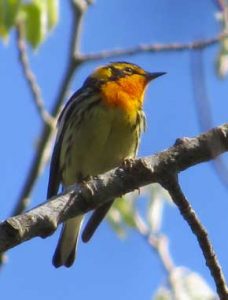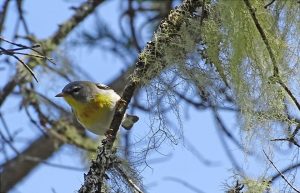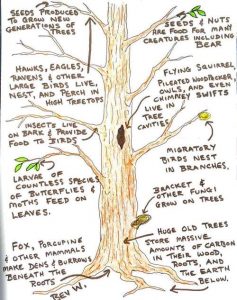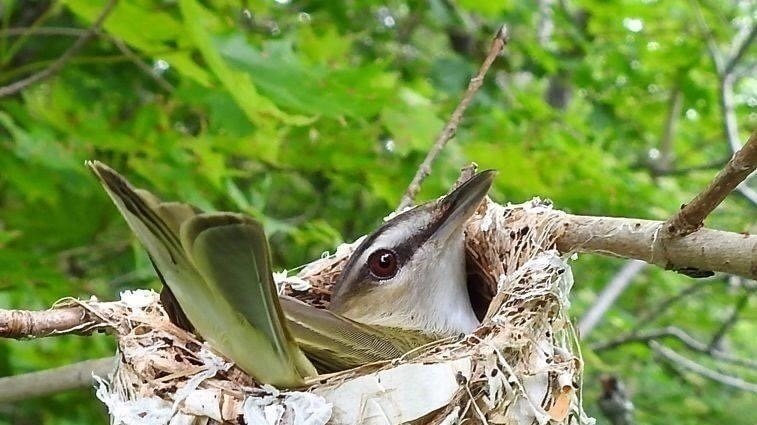
Blackburnian Warbler photographed by Angela Granchelli
June 18 am, 2020 : 5,232 have signed on
A petition launched by Bev Wigney of the public Facebook group Annapolis Royal & Area – Environment & Ecology just before noon on June 6, 2020, to “Protect birds from being destroyed during nesting season” had reached 1000 signatures by 4 pm today.
While Bev Wigney writes from Nova Scotia where our forests are amongst the most, if not the most, intensively harvested in Canada, currently and historically, she comments “I am hoping this will go out across Canada to all the other provinces where nesting birds are being threatened by industrial activity. This is a federal matter so this is a Canada-wide campaign.”
Reads the introduction to the petition on change.org:
Each year, many hundreds of thousands of birds make their journey from wintering grounds in Mexico, Central and South America, to forests across Canada. They will spend their spring and summer building nests, laying eggs, feeding and raising their young before making the long journey south in autumn.
The Migratory Birds Convention Act (MBCA) was initiated to protect birds during the very critical few weeks while they are on breeding territory, building nests and raising their young. Unfortunately, with the rise of industrial forestry, using large harvesting machines, a whole forest can be cut down and hauled away in just a few days. Any birds that happen to be nesting in such forests are certain to be destroyed or forced to abandon their nests and eggs. Most of these birds have spent 5 to 10 days building their nest, laying eggs, and have begun incubation. Many have young that have hatched and are being fed until they can fly. To destroy their nests is to destroy the likelihood that those birds will produce any young after their long and arduous, risk-filled migration from the south, and their investment in time and energy building nests and laying eggs.
We are told that industrial operators “watch for bird nests” as they operate their machines, or that some of the crews watch for nests. As any long time naturalist will tell you, even the most experienced bird watchers can find only a tiny fraction of the nests that are built as high as 30 metres above the ground, or in dense bushes, inside tree cavities, or in carefully hidden nests on the ground. The likelihood that industrial forestry crews in the midst of the roar of their machinery are actually finding nests is, quite frankly, entirely ludicrous.
Is it right that we humans should destroy so many birds through what is referred to as “incidental take” – a term used to describe “the unintentional, but not unexpected” destruction of wildlife? Should migratory birds pay the ultimate price with their lives so that forests can be taken down to make 2x4s, or pulp to make toilet paper?
We are calling on Jonathan Wilkinson, Minister of Environment and Climate Change, to insist that the Migratory Birds Convention Act be properly enforced in a pre-emptive way. We know that the Act is not being used in a pre-emptive way, and employed only as a means of punishing only the most egregious cases of destruction “after the fact”. That is doing nothing for prevention of loss of life. The most effective means of preventing destruction would be through the establishment of a “singing season” (a period when birds are on nesting territory) during which there be no industrial forestry or similarly destructive operations taking place, threatening the lives of birds and other wildlife that are raising young at that time. Progressive forestry operators are already doing as much. It is time for ALL industrial operators to stay out of the forest during this critical time. Please sign this petition calling for the establishment of a formal time period – appropriate for each region of Canada – during which forestry operations be properly restricted to allow migratory birds to nest and raise their young.
Some related posts on NSFN

In Nova Scotia, the Northern Parula (a wood warbler) shrouds its nest in Beard Lichen (Usnea spp) “where they are impossible to spot except by the actions of the parent birds” – Audubon (Photo taken in forest by Gays River, Nova Scotia on May 19, 2018)
Nesting season in full swing and still no “Silent Season” for forestry in Nova Scotia 26May2020
Posted on May 26, 2020
Bev Wigney on proposed changes to the Canada Migratory Bird Regulations that would allow exceptions to the prohibition against disturbance of nests 24July2019
Posted on July 24, 2019
“Re: Imminent violations of the Migratory Birds Convention Act in Shelburne County, NS” 23July2019
Posted on July 23, 2019 by admin
Annapolis Ecology Group seeks “Silent Summer Forestry” in Nova Scotia 28June2019
Posted on June 28, 2019

From a post on Annapolis Ecology by BW, about Super Canopy Trees
Logging at Nova Scotia’s Corbett-Dalhousie Lakes Crown land NOT delayed, WestFor’s Marcus Zwicker: “it would be inevitable that nests are destroyed” 12Jun2019
Posted on June 12, 2019
Logging at Nova Scotia’s Corbett-Dalhousie Lakes Crown land delayed by company doing the cut to respect Migratory Bird Convention Act 11Jun2019
Posted on June 11, 2019
Nova Scotia’s Corbett-Dalhousie Lakes Crown land scheduled to be harvested in nesting season, endangered turtle found in the lakes 5Jun2019
Posted on June 5, 2019
Intensive tree cull in Halifax’s Point Pleasant Park delayed until after nesting season; Nova Scotia L&F continues to ignore federal regs 12May2019
Posted on May 12, 2019
A letter to Information Morning (Nova Scotia) 22Mar2019
Posted on March 22, 2019
Are cats more destructive to Nova Scotia’s forest birds than clearcutting?
Posted on June 8, 2018
Birds nests versus industrial forestry in Nova Scotia & what the Independent Review can do for us
Posted on January 10, 2018
Crossland: federal Migratory Birds Convention Act ignored as habitat is cut for chips
Posted on July 22, 2017 by admin
Nova Scotia’s Clearcut Refugees
Posted on March 12, 2017

BW photo on The Petition

